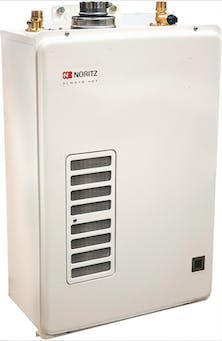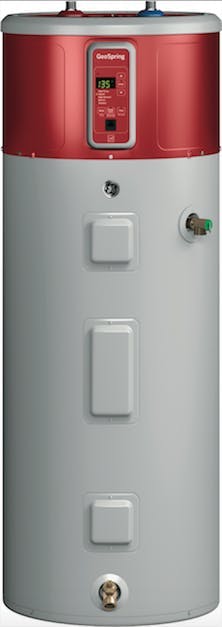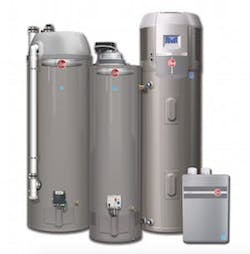It’s hard to imagine a well-appointed kitchen or a sumptuous bath without an ample supply of piping hot water flowing out of the taps. It’s the reason a good water heater is so important. But the way you specify those heaters in the homes you build changes forever this month. New standards set by the U.S. Department of Energy (DOE) and the National Appliance Energy Conservation Act will kick in on April 16, and they require higher energy factor (EF) ratings on all residential water heaters.
The standards apply to large- and small-capacity water heaters of all kinds. Water heaters that are 55 gallons or less must have an EF of 0.95, and units that are 56 gallons or more must have an EF of 1.98. What’s more, for electric water heaters larger than 55 gallons, heat pump technology is the only type currently capable of meeting the higher efficiency levels. (Though the new rules also raise the efficiency levels on gas tankless water heaters, most models already meet the requirements.)
Savings in Utility Bills, Emissions, Energy
“For gas water heaters, anything under 55 gallons will be impacted slightly and anything over 55 gallons—whether it’s gas or electric—is going to be impacted significantly,” says Mike Siuda, director of tankless sales and marketing at Atlanta-based Rheem Manufacturing. “That means water heaters over 55 gallons will require significant changes to the way they’re built.”
Water heating is one of the DOE’s priorities because it accounts for about 20 percent of a home’s electricity bill. The agency says that the higher standards are good for consumers and the country, helping to save money and playing a vital role in cutting carbon emissions. “Standards mandatory in 2015 will save approximately 3.3 quads of energy and result in approximately $63 billion in energy bill savings for products shipped from 2015–2044,” the agency says on its website. “The standard will avoid about 172.5 million metric tons of carbon dioxide emissions, equivalent to the annual greenhouse gas emissions of about 33.8 million automobiles."
Big Tanks Will Be Most Affected
There’s no question that the energy savings will be significant, but the rules bring major changes for the construction industry, especially for builders who specify big tanks in their homes. Say, for example, you’ve been using a 50-gallon electric water heater in your homes. The current standard calls for 0.90 percent efficiency; the new requirement calls for a modest increase to a 0.95 percent efficiency rating. On the other hand, if you were using a 65-gallon heater, the old standard was a 0.88 percent efficiency rating, while the new standard requires 1.98.
The new EZTR40 from Noritz is a tankless-for-tank replacement that is easy and affordable, the manufacturer says. It’s designed to replace a conventional 40-gallon tank-type water heater for two-bath residences in warm-weather climates.
Larger Heaters—and Yes, Heftier Price Tags
All this technology will force builders to rethink how they specify a water heater. Manufacturers had to modify the way they make the units in order to increase the performance, which resulted in bigger tanks and less installation flexibility. “For gas water heaters with 30-to-50-gallon storage tanks, the increase in minimum standards will trigger an increase in the insulation needed, resulting in up to 2 inches greater tank diameters,” says James York, vice president of engineering at Rinnai, in Peachtree City, Ga.
GE’s GeoSpring80 is a hybrid electric heat pump water heater that is 67 percent more efficient than a standard electric unit. It includes the same water and electrical connections as a standard electric water heater and boasts an energy factor of 2.9.
But just how much more expensive will these larger units be? Manufacturers say that builders, remodelers, and contractors will likely see a price increase of up to 35 percent. “[The efficiency] is going to come at a steep price tag,” Siuda says. According to the NAHB, “conventional, current minimum-efficiency 60-gallon gas and electric water heaters are approximately $675 to $1,500, while the new high-efficiency models are about $1,200 to $2,450."
Manufacturers Are on the Case
Aware of the impending rule changes, manufacturers have been updating their products and production capacity to address the new requirements. Bradford White, in Ambler, Pa., says that it’s in the middle of the largest plant expansion in the company’s history to meet growing demand and to accommodate the production of additional 2015-ready products.
GE, which produces the GeoSpring heat pump heater, recently released the GeoSpring 80G. It’s available in a pro model for builders ($2,099) and a retail version ($1,999). Both models exceed the 2015 standards: the pro model with EF of 3.1 and the retail version at 2.9.
But just how much more expensive will these larger units be? Manufacturers say that builders, remodelers, and contractors will likely see a price increase of up to 35 percent. “[The efficiency] is going to come at a steep price tag,” Siuda says. According to the NAHB, “conventional, current minimum-efficiency 60-gallon gas and electric water heaters are approximately $675 to $1,500, while the new high-efficiency models are about $1,200 to $2,450."
Rheem offers 40 products that already meet or exceed the new standard, including a high-efficiency condensing direct vent, XR90 gas unit, and a hybrid electric heat pump.
Milwaukee-based A. O. Smith also offers high-efficiency water heaters that meet and surpass the standards, including the Voltex heat pump unit, the Vertex power-vent and power direct-vent gas, as well as various tankless product lines. “Still, there are changes to be made,” says Ralph Perez, the company’s director of residential product management. “Our manufacturing plants have been retooled, product literature is being updated, and efforts to educate our contracting partners are under way."
Tanks or No Tanks?
Even tankless makers are prepared for the new law. Noritz America, in Fountain Valley, Calif., developed the EZTR40 as a replacement for the 40-gallon tank heater. “With all the space and size issues builders and consumers could potentially face, we believe tankless is the solution to the problem,” says Jason Fleming, marketing manager for Noritz. “And with our new [EZTR40] product, it will be able to utilize the vent and water lines that are already there.” Tankless manufacturers say that the new standard is a golden opportunity for them and plays into their strengths. Their logic is simple: The price for a heat-pump unit and a tankless is now about the same, but tankless isn’t constantly drawing power, so it’s a better option.
In a competitive market such as Southern California, tankless costs about $1,799 and a tank heater costs about $1,300 on average, Fleming says. “But that’s the cost before the new standard,” he points out. “If the price for tank systems is going up 30 or 35 percent, that makes the proposition between tank and tankless a pretty viable conversation.”
Prepare for Floor Plan Changes
“Builders who are designing new homes must take space and the size of these new water heaters into account when starting a job,” says Gina Perry, product merchant for water heaters at The Home Depot, in Atlanta. “Living space in a new home may need to be reduced to account for the larger water heaters. Luckily, builders who haven’t started work on a particular job can take this into account beforehand.”
Offering a 0.96 percent efficiency rating, the Vertex 100 75-gallon gas unit by A.O. Smith comes in a power-vent and power direct-vent model and is ideal for high-demand applications.
But builders doing remodeling work or expansion projects face different challenges, so they may have to redesign the home’s water heater closet, downsize to a smaller gallon water heater and add a thermostatic mixing valve to help boost output, or go completely tankless, Perry says.
If you specify larger tanks, they likely will not fit into the standard 3 foot by 3 foot closet. Additionally, if you’re using a heat pump appliance it will need to be installed in locations that remain in the 40-to-90-degree range year-round and provide at least 1,000 cubic feet of surrounding air space. Moreover, heat pump water heaters remove ambient heat from the house, so it’s better to install them in warmer areas of the country where the cooling effect of the unit will reduce the air conditioning load on the house, the NAHB says.
Broach the Subject Now
Using two smaller electric tanks instead of one large heat pump unit is another option. One unit could be dedicated to baths, while the other is dedicated to appliances. Builders could also split up use based on levels of the home. If placed at opposite ends of the building and closer to the point of use, homeowners conserve water and energy by eliminating excess piping, the NAHB says. Manufacturers, however, say that this option could be just as expensive as a single large tank.
Unlike, say, Energy Star or WaterSense, these standards are not voluntary, so builders will have no choice in the matter. Manufacturers will stop producing units with the old technology and make only heaters with the new technology. Vendors will still sell older models manufactured before April 16. But when inventory is exhausted, that will be it.
In the end, manufacturers believe that builders—especially forward-thinking ones that are already doing high-performance homes, Energy Star, or LEED—will embrace the changes and specify the most energy-efficient units available.“Contractors who do new-construction work should start discussing these changes with their clients now,” Perez says. “That way everyone is thinking about how future projects and planning budgets are designed and funded to accommodate the 2015 product choices. There will be a transition period, but ultimately, it’s much easier and more cost effective to design for different equipment in new construction simply because one is starting with a blank canvas.”
Nigel F. Maynard writes about building and design for various consumer and business publications.





